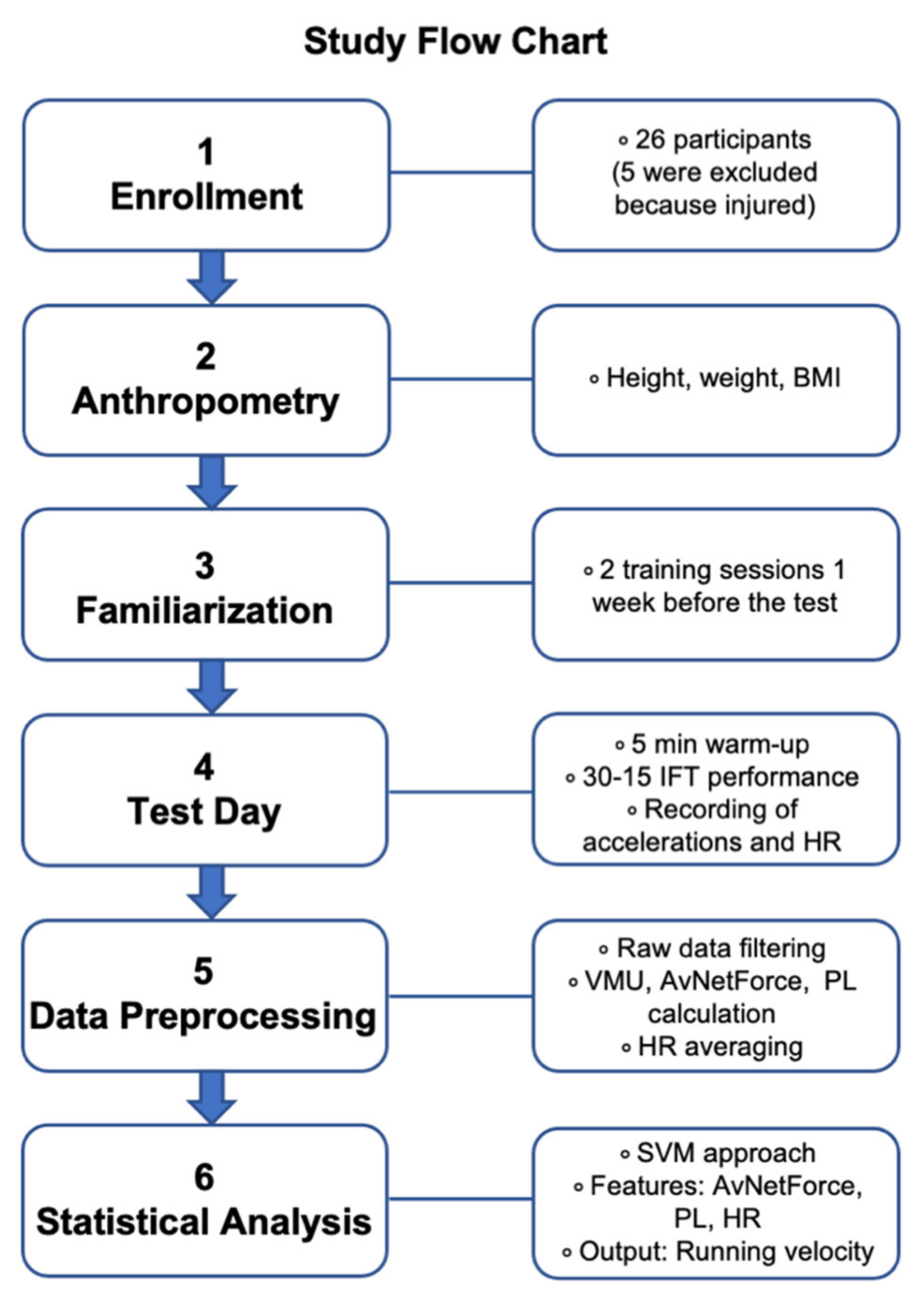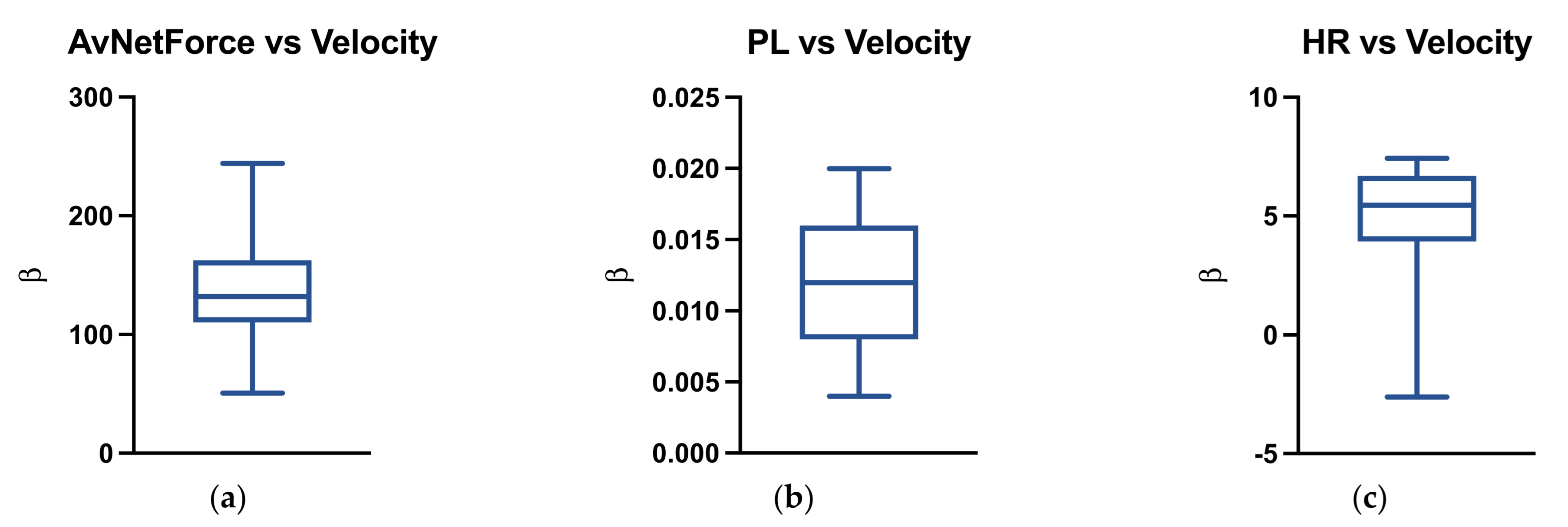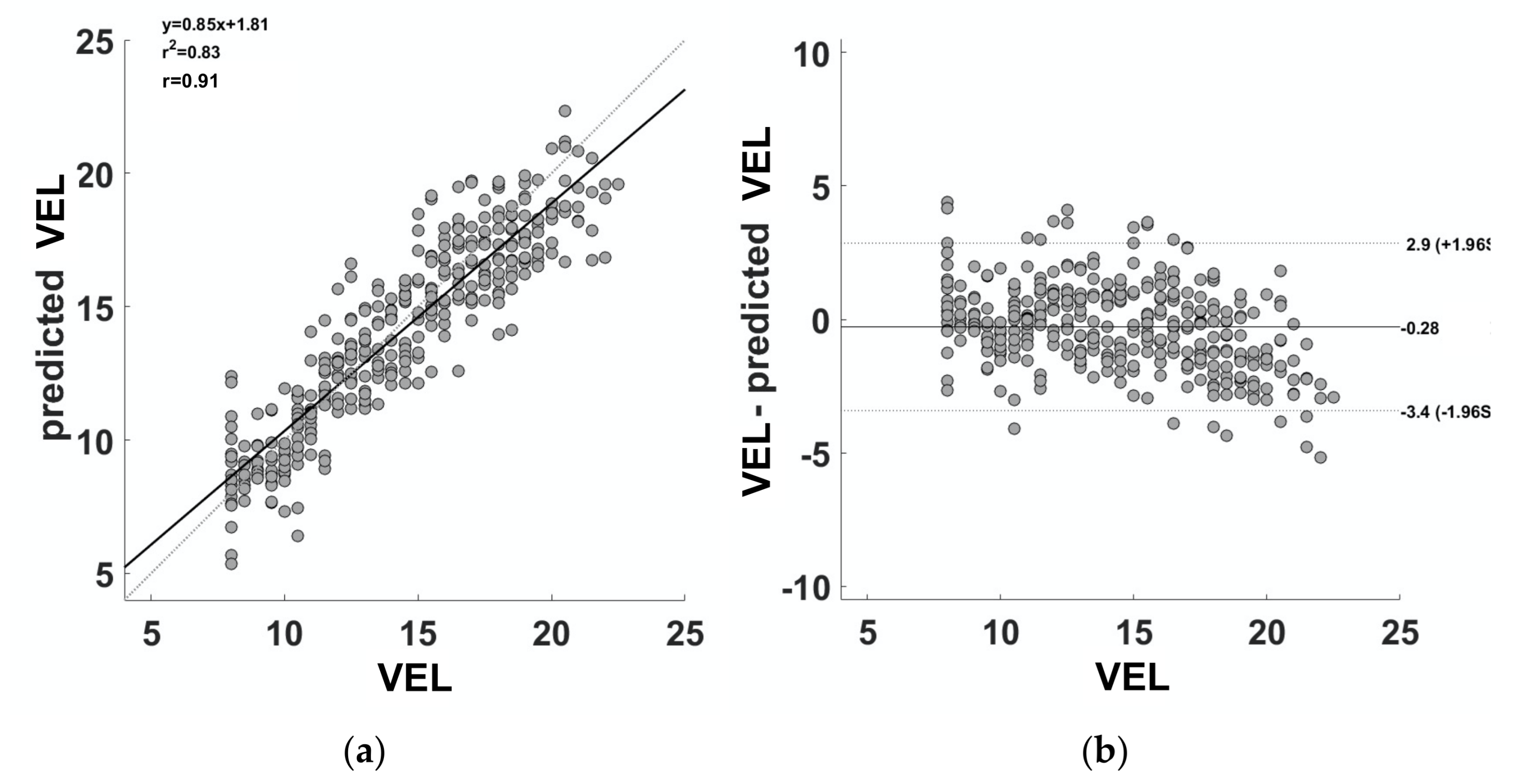The Prediction of Running Velocity during the 30–15 Intermittent Fitness Test Using Accelerometry-Derived Metrics and Physiological Parameters: A Machine Learning Approach
Abstract
:1. Introduction
2. Materials and Methods
2.1. Participants
2.2. Height, Weight and BMI
2.3. Procedures
2.4. The 30–15 Intermittent Fitness Test
2.5. Preprocessing
2.6. Statistical Analysis
3. Results
3.1. Descriptive Statistics, Correlation Analysis and in-Sample Linear Regression
3.2. SVM and Agreement
4. Discussion
5. Conclusions
Author Contributions
Funding
Institutional Review Board Statement
Informed Consent Statement
Data Availability Statement
Conflicts of Interest
References
- Bourdon, P.C.; Cardinale, M.; Murray, A.; Gastin, P.; Kellmann, M.; Varley, M.C.; Gabbett, T.J.; Coutts, A.J.; Burgess, D.J.; Gregson, W.; et al. Monitoring athlete training loads: Consensus statement. Int. J. Sports Physiol. Perform. 2017, 12, S2-161–S2-170. [Google Scholar] [CrossRef] [PubMed]
- Marino, F.E. Physiology—laboratory and clinical research. In Regulation of Fatigue in Exercise; Nova Science Publishers: Hauppauge, NY, USA, 2011; ISBN 978-1-61209-334-5. [Google Scholar]
- Impellizzeri, F.M.; Menaspà, P.; Coutts, A.J.; Kalkhoven, J.; Menaspà, M.J. Training load and its role in injury prevention, Part I: Back to the future. J. Athl. Train. 2020, 55, 885–892. [Google Scholar] [CrossRef]
- McLaren, S.J.; Macpherson, T.W.; Coutts, A.J.; Hurst, C.; Spears, I.R.; Weston, M. The relationships between internal and external measures of training load and intensity in team sports: A meta-analysis. Sports Med. 2018, 48, 641–658. [Google Scholar] [CrossRef] [PubMed] [Green Version]
- Halson, S.L. Monitoring training load to understand fatigue in athletes. Sports Med. 2014, 44, 139–147. [Google Scholar] [CrossRef] [PubMed] [Green Version]
- Impellizzeri, F.M.; Marcora, S.M.; Coutts, A.J. Internal and external training load: 15 years on. Int. J. Sports Physiol. Perform. 2019, 14, 270–273. [Google Scholar] [CrossRef] [PubMed]
- Izzicupo, P.; D’Amico, M.A.; Bascelli, A.; Di Fonso, A.; D’Angelo, E.; Di Blasio, A.; Bucci, I.; Napolitano, G.; Gallina, S.; Di Baldassarre, A. Walking training affects dehydroepiandrosterone sulfate and inflammation independent of changes in spontaneous physical activity. Menopause 2013, 20, 455–463. [Google Scholar] [CrossRef] [PubMed]
- Falone, S.; Mirabilio, A.; Passerini, A.; Izzicupo, P.; Cacchio, M.; Gallina, S.; Baldassarre, A.D.; Amicarelli, F. Aerobic performance and antioxidant protection in runners. Int. J. Sports Med. 2009, 30, 782–788. [Google Scholar] [CrossRef] [PubMed]
- Campos-Vazquez, M.A.; Toscano-Bendala, F.J.; Mora-Ferrera, J.C.; Suarez-Arrones, L.J. Relationship between internal load indicators and changes on intermittent performance after the preseason in professional soccer players. J. Strength Cond. Res. 2017, 31, 1477–1485. [Google Scholar] [CrossRef]
- Stiles, V.H.; Pearce, M.; Moore, I.S.; Langford, J.; Rowlands, A.V. Wrist-worn accelerometry for runners: Objective quantification of training load. Med. Sci. Sports Exerc. 2018, 50, 2277–2284. [Google Scholar] [CrossRef] [Green Version]
- Polglaze, T.; Dawson, B.; Hiscock, D.J.; Peeling, P. A comparative analysis of accelerometer and time-motion data in elite men’s hockey training and competition. Int. J. Sports Physiol. Perform. 2015, 10, 446–451. [Google Scholar] [CrossRef]
- Borresen, J.; Lambert, M.I. The quantification of training load, the training response and the effect on performance. Sports Med. 2009, 39, 779–795. [Google Scholar] [CrossRef] [PubMed]
- Haddad, M.; Stylianides, G.; Djaoui, L.; Dellal, A.; Chamari, K. Session-RPE method for training load monitoring: Validity, ecological usefulness, and influencing factors. Front. Neurosci. 2017, 11, 612. [Google Scholar] [CrossRef] [PubMed]
- Malone, S.; Hughes, B.; Collins, K.; Akubat, I. Methods of monitoring training load and their association with changes across fitness measures in hurling players. J. Strength Cond. Res. 2020, 34, 225–234. [Google Scholar] [CrossRef]
- Izzicupo, P.; Ghinassi, B.; D’Amico, M.A.; Di Blasio, A.; Gesi, M.; Napolitano, G.; Gallina, S.; Di Baldassarre, A. Effects of ACE I/D polymorphism and aerobic training on the immune-endocrine network and cardiovascular parameters of postmenopausal women. J. Clin. Endocrinol. Metab. 2013, 98, 4187–4194. [Google Scholar] [CrossRef] [Green Version]
- Izzicupo, P.; Di Valerio, V.; D’Amico, M.A.; Di Mauro, M.; Pennelli, A.; Falone, S.; Alberti, G.; Amicarelli, F.; Miscia, S.; Gallina, S.; et al. Nad(P)H oxidase and pro-inflammatory response during maximal exercise: Role of C242T polymorphism of the P22PHOX subunit. Int. J. Immunopathol. Pharmacol. 2010, 23, 203–211. [Google Scholar] [CrossRef]
- Buchheit, M.; Laursen, P.B. High-intensity interval training, solutions to the programming puzzle: Part I: Cardiopulmonary emphasis. Sports Med. 2013, 43, 313–338. [Google Scholar] [CrossRef]
- Billat, V. Interval training for performance: A scientific and empirical practice. Special recommendations for middle- and long-distance running. Part I: Aerobic interval training. Sports Med. 2001, 31, 13–31. [Google Scholar] [CrossRef]
- Iaia, F.M.; Bangsbo, J. Speed endurance training is a powerful stimulus for physiological adaptations and performance improvements of athletes. Scand. J. Med. Sci. Sports 2010, 20, 11–23. [Google Scholar] [CrossRef] [PubMed]
- Kelly, D.T.; Tobin, C.; Egan, B.; McCarren, A.; O’Connor, P.L.; McCaffrey, N.; Moyna, N.M. Comparison of sprint interval and endurance training in team sport athletes. J. Strength Cond. Res. 2018, 32, 3051–3058. [Google Scholar] [CrossRef]
- Engel, F.A.; Ackermann, A.; Chtourou, H.; Sperlich, B. High-intensity interval training performed by young athletes: A systematic review and meta-analysis. Front. Physiol. 2018, 9, 1012. [Google Scholar] [CrossRef] [PubMed] [Green Version]
- Di Credico, A.; Gaggi, G.; Ghinassi, B.; Mascherini, G.; Petri, C.; Di Giminiani, R.; Di Baldassarre, A.; Izzicupo, P. The influence of maturity status on anthropometric profile and body composition of youth goalkeepers. Int. J. Environ. Res. Public Health 2020, 17, 8247. [Google Scholar] [CrossRef] [PubMed]
- Laursen, P.B.; Jenkins, D.G. The scientific basis for high-intensity interval training: Optimising training programmes and maximising performance in highly trained endurance athletes. Sports Med. 2002, 32, 53–73. [Google Scholar] [CrossRef]
- Gibala, M.J.; Little, J.P.; MacDonald, M.J.; Hawley, J.A. Physiological adaptations to low-volume, high-intensity interval training in health and disease. J. Physiol. 2012, 590, 1077–1084. [Google Scholar] [CrossRef]
- Di Credico, A.; Izzicupo, P.; Gaggi, G.; Di Baldassarre, A.; Ghinassi, B. Effect of physical exercise on the release of microparticles with angiogenic potential. Appl. Sci. 2020, 10, 4871. [Google Scholar] [CrossRef]
- Gibala, M.J.; McGee, S.; Garnham, A.P.; Howlett, K.; Snow, R.J.; Hargreaves, M. Brief intense interval exercise activates AMPK and p38 MAPK signaling and increases the expression of PGC-1α in human skeletal muscle. J. Appl. Physiol. 2009, 106, 929–934. [Google Scholar] [CrossRef] [PubMed] [Green Version]
- Bangsbo, J.; Iaia, F.M.; Krustrup, P. The yo-yo intermittent recovery test. Sports Med. 2008, 38, 37–51. [Google Scholar] [CrossRef]
- Buchheit, M. The 30-15 intermittent fitness test: Accuracy for individualizing interval training of young intermittent sport players. J. Strength Cond. Res. 2008, 22, 365–374. [Google Scholar] [CrossRef] [PubMed] [Green Version]
- Dupont, G.; Defontaine, M.; Bosquet, L.; Blondel, N.; Moalla, W.; Berthoin, S. Yo-Yo intermittent recovery test versus the Université de Montréal track test: Relation with a high-intensity intermittent exercise. J. Sci. Med. Sport 2010, 13, 146–150. [Google Scholar] [CrossRef]
- Iv, J.J.D.; Gruber, A.H. Quantifying exposure to running for meaningful insights into running-related injuries. BMJ Open Sport Exerc. Med. 2019, 5, e000613. [Google Scholar] [CrossRef] [Green Version]
- Izzicupo, P.; Di Blasio, A.; Di Credico, A.; Gaggi, G.; Vamvakis, A.; Napolitano, G.; Ricci, F.; Gallina, S.; Ghinassi, B.; Di Baldassarre, A. The length and number of sedentary bouts predict fibrinogen levels in postmenopausal women. Int. J. Environ. Res. Public Health 2020, 17, 3051. [Google Scholar] [CrossRef]
- Aadland, E.; Ylvisåker, E. Reliability of the actigraph GT3X+ accelerometer in adults under free-living conditions. PLoS ONE 2015, 10, e0134606. [Google Scholar] [CrossRef] [Green Version]
- Clark, B.K.; Healy, G.N.; Winkler, E.A.H.; Gardiner, P.A.; Sugiyama, T.; Dunstan, D.W.; Matthews, C.E.; Owen, N. Relationship of television time with accelerometer-derived sedentary time. Med. Sci. Sports Exerc. 2011, 43, 822–828. [Google Scholar] [CrossRef] [PubMed] [Green Version]
- Colby, M.J.; Dawson, B.; Heasman, J.; Rogalski, B.; Gabbett, T.J. Accelerometer and GPS-derived running loads and injury risk in elite australian footballers. J. Strength Cond. Res. 2014, 28, 2244–2252. [Google Scholar] [CrossRef] [PubMed]
- Hennessy, L.; Jeffreys, I. The current use of GPS, its potential, and limitations in soccer. Strength Cond. J. 2018, 40, 83–94. [Google Scholar] [CrossRef]
- Gómez-Carmona, C.D.; Bastida-Castillo, A.; Ibáñez, S.J.; Pino-Ortega, J. Accelerometry as a method for external workload monitoring in invasion team sports. A systematic review. PLoS ONE 2020, 15, e0236643. [Google Scholar] [CrossRef]
- Staunton, C.; Wundersitz, D.; Gordon, B.; Kingsley, M. Construct validity of accelerometry-derived force to quantify basketball movement patterns. Int. J. Sports Med. 2017, 38, 1090–1096. [Google Scholar] [CrossRef]
- Staunton, C.; Wundersitz, D.; Gordon, B.; Kingsley, M. Accelerometry-derived relative exercise intensities in elite women’s basketball. Int. J. Sports Med. 2018, 39, 822–827. [Google Scholar] [CrossRef]
- Boyd, L.J.; Ball, K.; Aughey, R.J. The reliability of MinimaxX accelerometers for measuring physical activity in Australian football. Int. J. Sports Physiol. Perform. 2011, 6, 311–321. [Google Scholar] [CrossRef] [PubMed]
- Fulkerson, B. Machine learning, neural and statistical classification. Technometrics 1995, 37, 459. [Google Scholar] [CrossRef]
- Cust, E.E.; Sweeting, A.J.; Ball, K.; Robertson, S. Machine and deep learning for sport-specific movement recognition: A systematic review of model development and performance. J. Sports Sci. 2019, 37, 568–600. [Google Scholar] [CrossRef] [PubMed]
- Bassett, D.R.; Rowlands, A.; Trost, S. Calibration and validation of wearable monitors. Med. Sci. Sports Exerc. 2012, 44, S32–S38. [Google Scholar] [CrossRef] [PubMed] [Green Version]
- Farrahi, V.; Niemela, M.; Tjurin, P.; Kangas, M.; Korpelainen, R.; Jamsa, T. Evaluating and enhancing the generalization performance of machine learning models for physical activity intensity prediction from raw acceleration data. IEEE J. Biomed. Health Inform. 2020, 24, 27–38. [Google Scholar] [CrossRef] [Green Version]
- Kerr, J.; Carlson, J.; Godbole, S.; Cadmus-Bertram, L.; Bellettiere, J.; Hartman, S. Improving hip-worn accelerometer estimates of sitting using machine learning methods. Med. Sci. Sports Exerc. 2018, 50, 1518–1524. [Google Scholar] [CrossRef] [PubMed]
- Winter, E.M.; Maughan, R.J. Requirements for ethics approvals. J. Sports Sci. 2009, 27, 985. [Google Scholar] [CrossRef] [PubMed]
- Cormack, S.; Smith, R.L.; Mooney, M.M.; Young, W.B.; O’Brien, B. Accelerometer load as a measure of activity profile in different standards of netball match play. Int. J. Sports Physiol. Perform. 2014, 9, 283–291. [Google Scholar] [CrossRef] [PubMed]
- Nicolella, D.P.; Torres-Ronda, L.; Saylor, K.J.; Schelling, X. Validity and reliability of an accelerometer-based player tracking device. PLoS ONE 2018, 13, e0191823. [Google Scholar]
- Schober, P.; Boer, C.; Schwarte, L.A. Correlation coefficients: Appropriate Use and Interpretation. Anesth. Analg. 2018, 126, 1763–1768. [Google Scholar] [CrossRef] [PubMed]
- Vehtari, A.; Gelman, A.; Gabry, J. Practical bayesian model evaluation using leave-one-out cross-validation and WAIC. Stat. Comput. 2017, 27, 1413–1432. [Google Scholar] [CrossRef] [Green Version]
- Grünbichler, J.; Federolf, P.; Gatterer, H. Workload efficiency as a new tool to describe external and internal competitive match load of a professional soccer team: A descriptive study on the relationship between pre-game training loads and relative match load. Eur. J. Sport Sci. 2020, 20, 1034–1041. [Google Scholar] [CrossRef] [PubMed]
- Rago, V.; Brito, J.; Figueiredo, P.; Costa, J.; Barreira, D.; Krustrup, P.; Rebelo, A. Methods to collect and interpret external training load using microtechnology incorporating GPS in professional football: A systematic review. Res. Sports Med. 2019, 28, 437–458. [Google Scholar] [CrossRef]
- Aughey, R. Applications of GPS technologies to field sports. Int. J. Sports Physiol. Perform. 2011, 6, 295–310. [Google Scholar] [CrossRef] [PubMed] [Green Version]
- Laursen, P.; Buchheit, M. Science and Application of High-Intensity Interval Training: Solutions to the Programming Puzzle; Human Kinetics: Champaign, IL, USA, 2019; ISBN 978-1-4925-5212-3. [Google Scholar]
- Buchheit, M.; Laursen, P.B. High-intensity interval training, solutions to the programming puzzle: Part II: Anaerobic energy, neuromuscular load and practical applications. Sports Med. 2013, 43, 927–954. [Google Scholar] [CrossRef] [PubMed]
- LeCun, Y.; Bengio, Y.; Hinton, G. Deep learning. Nature 2015, 521, 436–444. [Google Scholar] [CrossRef] [PubMed]
- Filippini, C.; Cardone, D.; Perpetuini, D.; Chiarelli, A.; Gualdi, G.; Amerio, P.; Merla, A. Convolutional neural networks for differential diagnosis of raynaud’s phenomenon based on hands thermal patterns. Appl. Sci. 2021, 11, 3614. [Google Scholar] [CrossRef]




| M ± SD | Min–Max | CV (%) | |
|---|---|---|---|
| Age (years) | 26.72 ± 6.43 | 20–41 | 24.08 |
| Height (cm) | 177.5 ± 8.08 | 157–190.2 | 4.55 |
| Weight (kg) | 71.93 ± 11.14 | 48.4–94 | 15.49 |
| BMI | 22.71 ± 2.36 | 19.21–28.55 | 10.39 |
| Min HR (bpm) | 59.8 ± 8.53 | 49–79 | 14.26 |
| Max HR (bpm) | 197.07 ± 8.39 | 181–209 | 4.27 |
| VIFT (km/h) | 19.78 ± 0.94 | 18.5–21.5 | 4.77 |
| r | z-Statistics (SVM vs. UNIVARIATE) | p-Value | |
|---|---|---|---|
| SVM | 0.91 | - | - |
| AvNetForce | 0.73 | 7.78 | ~0 |
| PL | 0.62 | 10.43 | ~0 |
| HR | 0.87 | 2.53 | 0.01 |
Publisher’s Note: MDPI stays neutral with regard to jurisdictional claims in published maps and institutional affiliations. |
© 2021 by the authors. Licensee MDPI, Basel, Switzerland. This article is an open access article distributed under the terms and conditions of the Creative Commons Attribution (CC BY) license (https://creativecommons.org/licenses/by/4.0/).
Share and Cite
Di Credico, A.; Perpetuini, D.; Chiacchiaretta, P.; Cardone, D.; Filippini, C.; Gaggi, G.; Merla, A.; Ghinassi, B.; Di Baldassarre, A.; Izzicupo, P. The Prediction of Running Velocity during the 30–15 Intermittent Fitness Test Using Accelerometry-Derived Metrics and Physiological Parameters: A Machine Learning Approach. Int. J. Environ. Res. Public Health 2021, 18, 10854. https://doi.org/10.3390/ijerph182010854
Di Credico A, Perpetuini D, Chiacchiaretta P, Cardone D, Filippini C, Gaggi G, Merla A, Ghinassi B, Di Baldassarre A, Izzicupo P. The Prediction of Running Velocity during the 30–15 Intermittent Fitness Test Using Accelerometry-Derived Metrics and Physiological Parameters: A Machine Learning Approach. International Journal of Environmental Research and Public Health. 2021; 18(20):10854. https://doi.org/10.3390/ijerph182010854
Chicago/Turabian StyleDi Credico, Andrea, David Perpetuini, Piero Chiacchiaretta, Daniela Cardone, Chiara Filippini, Giulia Gaggi, Arcangelo Merla, Barbara Ghinassi, Angela Di Baldassarre, and Pascal Izzicupo. 2021. "The Prediction of Running Velocity during the 30–15 Intermittent Fitness Test Using Accelerometry-Derived Metrics and Physiological Parameters: A Machine Learning Approach" International Journal of Environmental Research and Public Health 18, no. 20: 10854. https://doi.org/10.3390/ijerph182010854
APA StyleDi Credico, A., Perpetuini, D., Chiacchiaretta, P., Cardone, D., Filippini, C., Gaggi, G., Merla, A., Ghinassi, B., Di Baldassarre, A., & Izzicupo, P. (2021). The Prediction of Running Velocity during the 30–15 Intermittent Fitness Test Using Accelerometry-Derived Metrics and Physiological Parameters: A Machine Learning Approach. International Journal of Environmental Research and Public Health, 18(20), 10854. https://doi.org/10.3390/ijerph182010854












